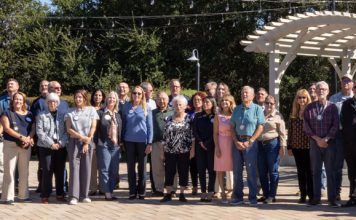Bullies, unions, growing schools, lunches and working in a community of great diversity are just some of the things Debbie Flores has dealt with in her decade at the helm of the Gilroy Unified School District. And just this month she was selected Superintendent of the Year by the Association of California School Administrators, a tremendous honor.
The Dispatch wanted to get her read on the past and future of our fast-growing school district.
Dispatch:What are some ways in which GUSD has changed during the 2015-2016 school year?
Flores: During the 2015-16 school year,the district has continued its focus on raising academic achievement for all students, which is reflected in several honors that we received this year, including the Golden Bell Award, California Association of Bilingual Educators (CABE) Seal of Excellence and two new Gold Ribbon Schools awards. GUSD also implemented the Sobrato Early Academic Language program in two of our elementary schools, with an expansion to three more schools planned for 2016-17.
Over the last year, the District has emphasized professional development for staff, created an administrative position to focus on school climate and attendance, launched a new school lunch program to focus on healthier, locally grown options for students and completed our facilities master plan and district-wide facilities needs assessment.
We have also increased our focus on internal and external communications with teachers and staff, parents, community partners and the city at-large to ensure the public is well-informed about key issues affecting the district, schools and students.
Dispatch: How much of a role does technology play in the classroom? Will its presence increase in the near future and, if so, how?
Flores: Over the last few years, the district has taken several actions to support the use of technology in the classroom. We created the information technology director position and added staff positions to IT to bolster the work of the department. We also created the educational technology coordinator position to support teachers in the classroom. Each of the district’s secondary school sites have dedicated technology teachers on special assignment (TOSAs). Over the last nine years, the number of computers and devices in the district has tripled and computer science classes are offered at both high schools. Teachers are using many effective software programs and Google Apps for Education to enhance instruction. We have also added Chromebooks at every site in the district, with more than 4200 Chromebooks currently in use.
Dispatch: Bullying, specifically cyber-bullying, has become a big issue in a lot of school districts. What steps are GUSD taking to prevent it?
Flores: Four years ago, the district adopted the Olweus Anti-Bullying program, trained teams of staff from school sites and implemented it at K-8 schools. This program focuses on preventing incidents of bullying, whether they are happening at school or online, by focusing on behaviors. Since implementation of Olweus, the district has seen a significant decrease in bullying incidents. This year, the district created the school climate administrative position in order to enhance these efforts. GUSD has also implemented the Character Counts and Positive Behavior Intervention and Supports (PBIS) programs, which focus on the development of positive character and behavior. Some of our school sites are implementing restorative justice circles in addition to these programs.
Dispatch: Has GUSD seen an increase or decrease in student enrollment? In staff and faculty numbers?
Flores: The district’s enrollment has grown steadily over the last several years. It has leveled off recently due to smaller kindergarten classes, but our studies indicate growth is coming due to the many new housing developments, especially those along the Santa Teresa corridor south of First Street. Due to the increase in student enrollment, additional staff has been hired at all levels.
Dispatch: What programs within GUSD do you want to see grow in the near future? What programs have grown in just the last year?
Flores: The district has one of the only K-12 Dual Immersion programs in the state, which recently received the prestigious Golden Bell award from the California School Boards Association (CSBA). The district will continue to support and expand this very successful program which is housed at Las Animas, Rod Kelley, South Valley and Gilroy High.
The BioMedical Science Academy at Gilroy High has been a huge success, and the District is exploring starting a second academy in either engineering or computer science at one of the high schools.
The Gilroy Early College Academy (GECA), located on the Gavilan College campus, is the highest performing early college academy in the state. We anticipate a slight increase in student enrollment over the next few years until reaching a capacity of 300 students.
Dispatch: You recently won the Superintendent of the Year award from the Association of California School Administrators. What originally made you get into education? What do you credit for your success?
Flores: I grew up helping church members and teaching the youth in my father’s churches. I was given major responsibilities and opportunities for leadership at a young age. Also, I started working at 14 to help support my family. I worked full-time in a factory at night during my junior and senior years in high school to save up for college. Through these experiences, I developed strong values and a strong work ethic. By high school, I knew I wanted to pursue a teaching career and wanted to work with children with disabilities. I devoted the first half of my career to special education, first as a teacher and then as an administrator. I also volunteered extensively in the community working with disabled adults. My values closely align with the pillars of Character Counts (trustworthiness, respect, responsibility, fairness, caring and citizenship), which I brought to GUSD nine years ago. In my day-to-day work as the GUSD superintendent, I work very hard and try to model these six pillars of good character. I am very committed to GUSD and strive to make it the best district it can be.
Dispatch: What was your favorite class in school? What is your favorite class currently taught within GUSD?
Flores: My favorite classes in high school were English classes. I love to read and we read some great novels and books. I also enjoy writing and had some great teachers of writing.
There are so many GUSD classes that I would like to take—I can’t choose just one. For instance, I wish I were in high school now and could take some of the biomedical science classes at Gilroy High, such as anatomy & physiology, principles of biomedicine, and biotechnology 1 and 2. I loved to sing in high school, but at my school we had only one (small) choir. If I were in high school now, I would take advantage of the incredible choirs offered at both high schools. I could list so many more—Advanced Placement classes, theater, debate, statistics and calculus. I would also play sports as I did in high school—basketball, volleyball and softball, and I would add track and field.
Dispatch: Teachers unions allow for strong collective bargaining for a profession that many consider perpetually underpaid. Given all of the positive aspects of such unions, do you believe they may foster an atmosphere that protects bad teachers?
Flores: I have worked with five Gilroy Teacher’s Association presidents and multiple negotiation teams during my time at GUSD. I believe they have all shared the same goal as the district, which is to provide a rigorous, high-quality education to all students. In order to achieve that goal, it is imperative that our district attract and retain a high-quality teaching staff. Salaries in GUSD have steadily increased (a 13 percent increase over the last three years), which has helped attract many great new teachers. We have worked closely together when a teacher’s performance falls below expectations, as our goal is to help them improve.
Dispatch: What are some challenges the district is currently facing?
Flores: One of our top needs is to find the funding to build a new elementary school in response to all the new housing developments. If we do not build a new elementary school, it will be necessary to add portables to most elementary sites and to change the school boundaries.
A comprehensive facilities needs assessment demonstrated that there are some major facilities needs in the district, including the reconstruction of two aging middle schools (Brownell and South Valley) and improvements and repairs at all 15 school sites that will help the district meet today’s safety, technological and educational standards.
In the instructional arena, meeting the needs of our English learners is a major area of focus this year and going forward. One of the top experts in the field, Kate Kinsella, is assisting the district with professional development for teachers, beginning with the elementary level this school year.
Dispatch: As Gilroy grows over the next 20 years, so will the demand for education. How ready is GUSD to meet those future needs?
Flores: I believe that GUSD is ready to meet those needs by continuing our focus on student achievement. Indicators over the last six years point to significant academic growth for our students. On the new CAASPP (California Assessment of Student Performance and Progress) testing, the district’s averages for most grade levels exceeded the state averages. The district will continue to provide professional development that focuses on the Common Core State Standards and the new assessments. We will also continue our use of innovative, signature programs that provide students with 21st-century skills, as well as our investment in technology in the classroom.
GUSD will meet the future needs of students by continuing to emphasize a college-going culture through the adoption of A-G as the default curriculum for all students, continuing the growth of our Advanced Placement program and class offerings at both high schools and by investing in our facilities needs.
Dispatch: Where do you see GUSD in the future? How do you believe you’ll foster that future?
Flores: I feel that the future of GUSD will be defined by a focus on increasing the level of academic achievement for all students and closing the achievement gap. As stated in our board goals, this means creating a rigorous, high-quality educational program at all school sites that supports best instructional practices and working to ensure that all students meet or exceed state and federal standards each year. The district will focus on growing and maintaining the quality of the district’s signature academic programs, which provide parents and students with a range of educational options. We will continue to provide consistent professional development to teachers to ensure the use of best instructional practices in all classrooms, as well as leadership development and training for administrators and staff. And we will work hard to maintain a close and collaborative relationship with the City of Gilroy and other community partners such as the Chamber of Commerce as we plan for the future of the city and the district, specifically the growth that is projected over the next 10 to 20 years.
Dispatch: What do you believe GUSD has to offer that other school districts may not?
Flores: GUSD offers signature programs that provide students a unique experience and cater to their particular academic and personal interests, while providing them with the strongest possible foundation for future success in a rapidly changing global economy. These programs include: Dual Immersion, BioMedical Science Academy, GATE (Gifted & Talented Education) program, GECA (GIlroy Early College Academy), choral music and band (elementary through high school), 20 Advanced Placement classes at each high school, an extensive sports program, model transitional kindergarten program at three elementary schools and Mt. Madonna, which is a Model Continuation High School. These programs help the district ensure that all students are provided with opportunities to excel and reach their greatest academic and personal potential.













